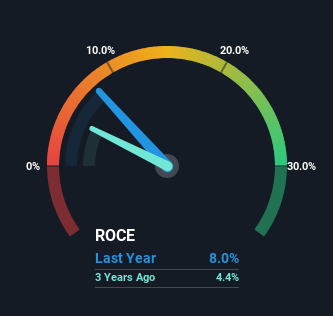Sakura Rubber (TSE:5189) Has Some Way To Go To Become A Multi-Bagger

What trends should we look for it we want to identify stocks that can multiply in value over the long term? In a perfect world, we'd like to see a company investing more capital into its business and ideally the returns earned from that capital are also increasing. Put simply, these types of businesses are compounding machines, meaning they are continually reinvesting their earnings at ever-higher rates of return. However, after investigating Sakura Rubber (TSE:5189), we don't think it's current trends fit the mold of a multi-bagger.
Understanding Return On Capital Employed (ROCE)
For those who don't know, ROCE is a measure of a company's yearly pre-tax profit (its return), relative to the capital employed in the business. The formula for this calculation on Sakura Rubber is:
Return on Capital Employed = Earnings Before Interest and Tax (EBIT) ÷ (Total Assets - Current Liabilities)
0.08 = JP¥858m ÷ (JP¥14b - JP¥3.5b) (Based on the trailing twelve months to December 2023).
Thus, Sakura Rubber has an ROCE of 8.0%. On its own that's a low return on capital but it's in line with the industry's average returns of 7.9%.
See our latest analysis for Sakura Rubber

While the past is not representative of the future, it can be helpful to know how a company has performed historically, which is why we have this chart above. If you're interested in investigating Sakura Rubber's past further, check out this free graph covering Sakura Rubber's past earnings, revenue and cash flow.
What Can We Tell From Sakura Rubber's ROCE Trend?
In terms of Sakura Rubber's historical ROCE trend, it doesn't exactly demand attention. Over the past five years, ROCE has remained relatively flat at around 8.0% and the business has deployed 22% more capital into its operations. Given the company has increased the amount of capital employed, it appears the investments that have been made simply don't provide a high return on capital.
The Bottom Line
Long story short, while Sakura Rubber has been reinvesting its capital, the returns that it's generating haven't increased. And investors appear hesitant that the trends will pick up because the stock has fallen 11% in the last five years. All in all, the inherent trends aren't typical of multi-baggers, so if that's what you're after, we think you might have more luck elsewhere.
On a final note, we found 3 warning signs for Sakura Rubber (2 don't sit too well with us) you should be aware of.
While Sakura Rubber may not currently earn the highest returns, we've compiled a list of companies that currently earn more than 25% return on equity. Check out this free list here.
New: Manage All Your Stock Portfolios in One Place
We've created the ultimate portfolio companion for stock investors, and it's free.
• Connect an unlimited number of Portfolios and see your total in one currency
• Be alerted to new Warning Signs or Risks via email or mobile
• Track the Fair Value of your stocks
Have feedback on this article? Concerned about the content? Get in touch with us directly. Alternatively, email editorial-team (at) simplywallst.com.
This article by Simply Wall St is general in nature. We provide commentary based on historical data and analyst forecasts only using an unbiased methodology and our articles are not intended to be financial advice. It does not constitute a recommendation to buy or sell any stock, and does not take account of your objectives, or your financial situation. We aim to bring you long-term focused analysis driven by fundamental data. Note that our analysis may not factor in the latest price-sensitive company announcements or qualitative material. Simply Wall St has no position in any stocks mentioned.
About TSE:5189
Excellent balance sheet average dividend payer.
Market Insights
Community Narratives



